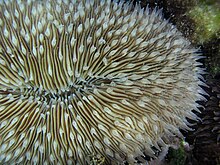Mushroom coral
| Fungiidae | |
|---|---|
 |
|
| Fungia scutaria | |
| Scientific classification | |
| Kingdom: | Animalia |
| Phylum: | Cnidaria |
| Class: | Anthozoa |
| Subclass: | Hexacorallia |
| Order: | Scleractinia |
| Family: |
Fungiidae Dana, 1846 |
| Genera | |
|
|
|
The Fungiidae /fəŋˈɡiː.ᵻdiː/ are a family of Cnidaria, often known as mushroom corals. The family contains thirteen extant genera. They range from solitary corals to colonial species. Some genera such as Cycloseris and Fungia are solitary organisms, Polyphyllia consists of a single organism with multiple mouths, and Ctenactis and Herpolitha might be considered as solitary organisms with multiple mouths or a colony of individuals, each with its separate mouth.
Species are generally marine animals capable of benthic locomotion. These corals often appear to be bleached or dead. In most genera, a single polyp emerges from the center of the skeleton to feed at night. Most species remain fully detached from the substrate in adulthood. Some are immobile as well as colonial.
Some species of mushroom coral such as Fungia repanda and Ctenactis echinata are able to change sex. This is posited to take place in response to environmental or energetic constraints, and to improve the organism's evolutionary fitness; similar phenomena are observed in some dioecious plants.
...
Wikipedia
